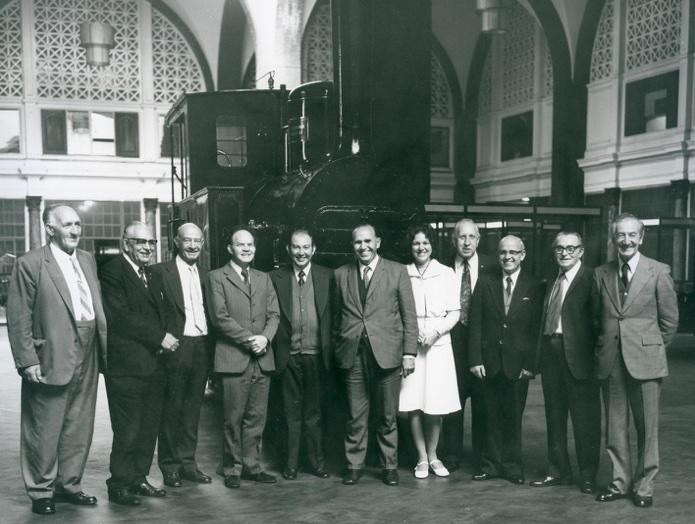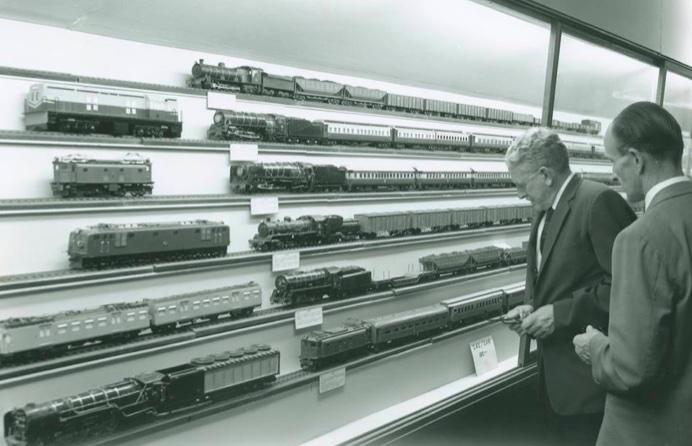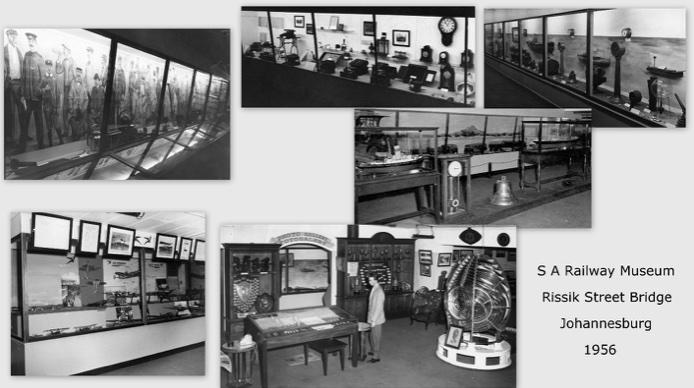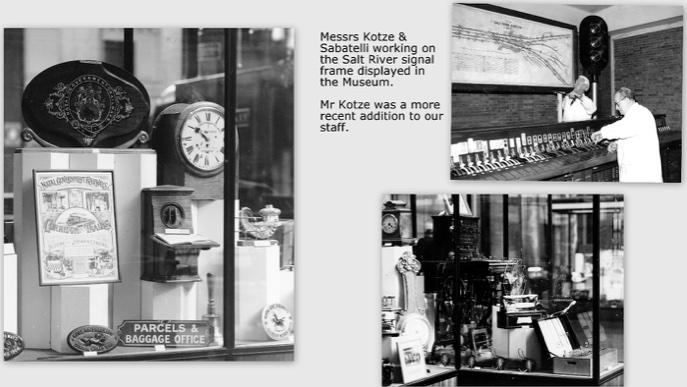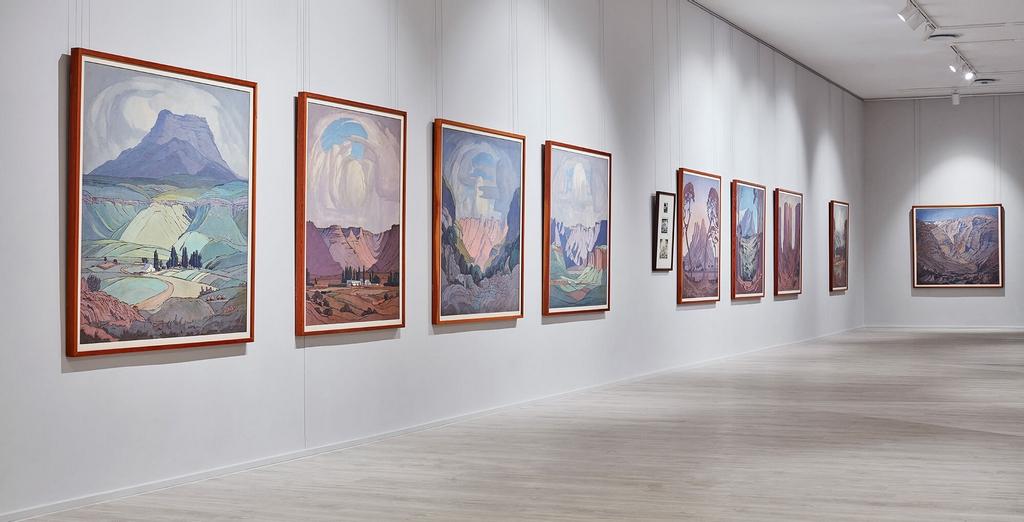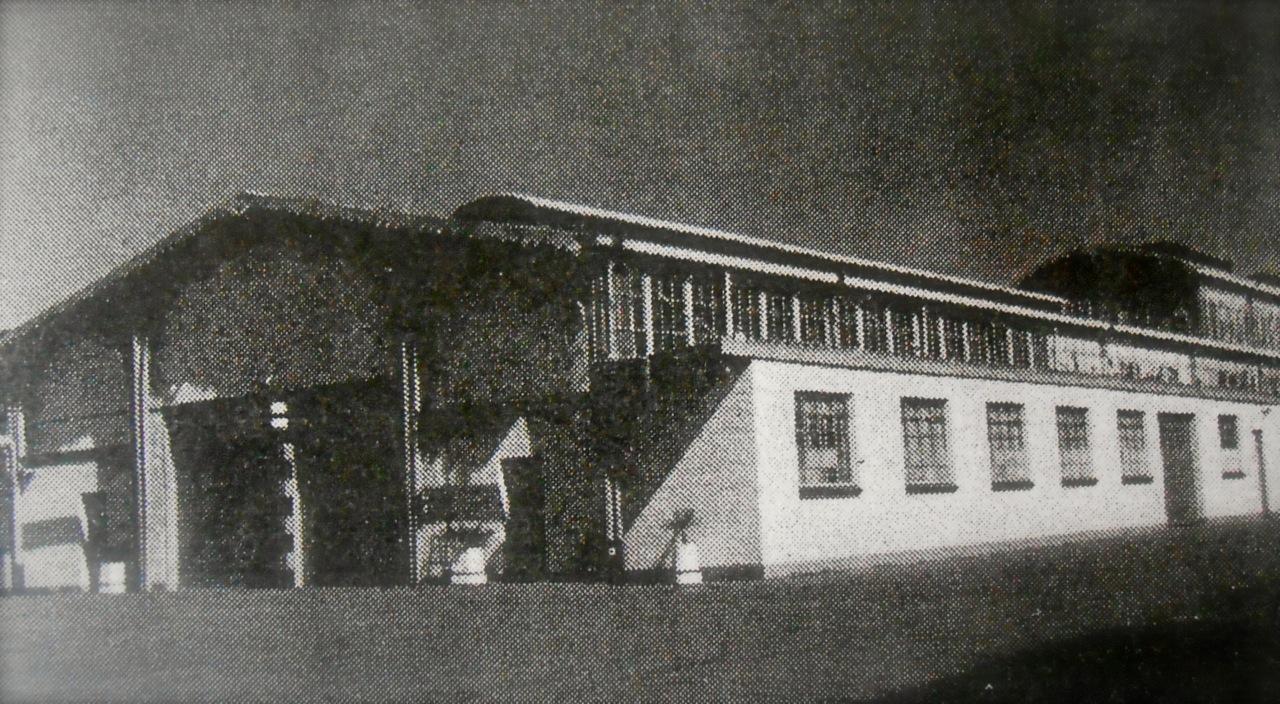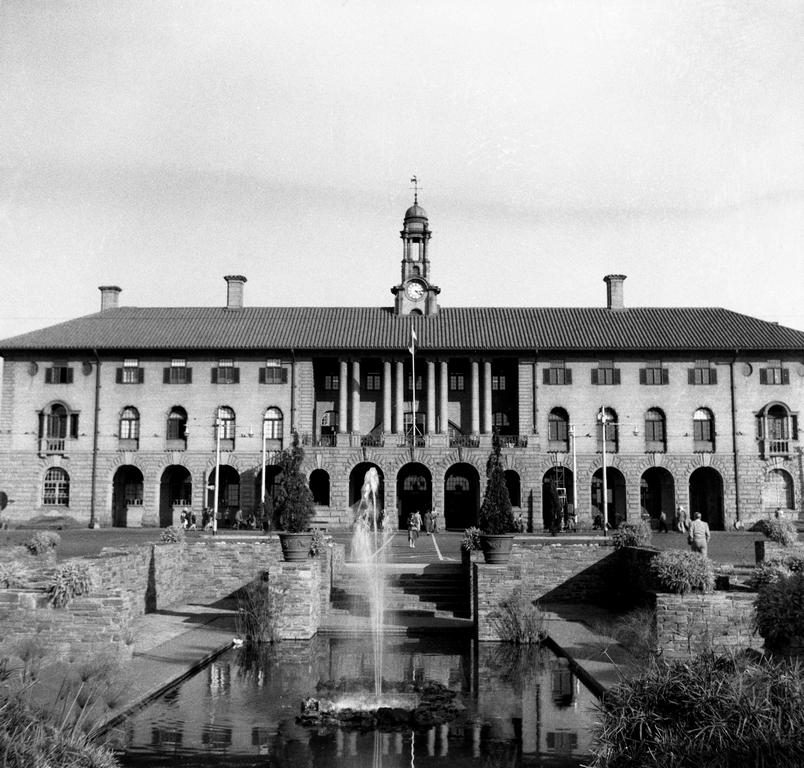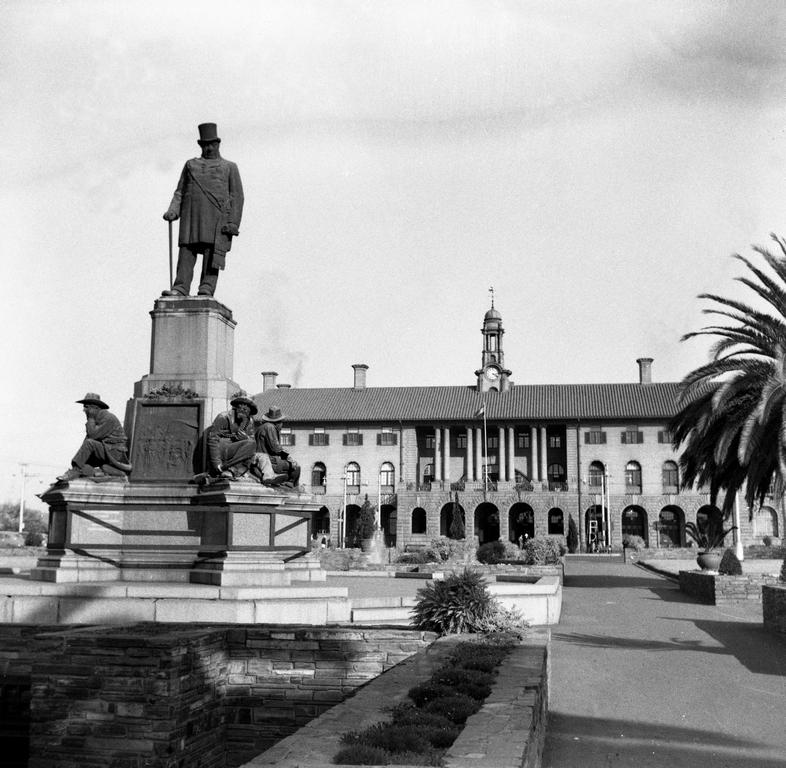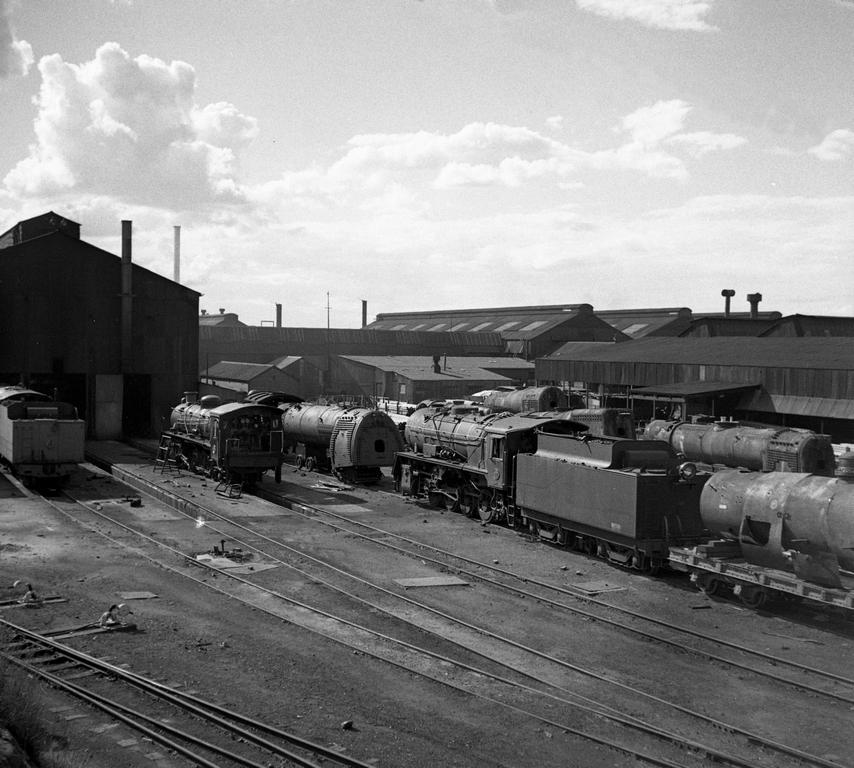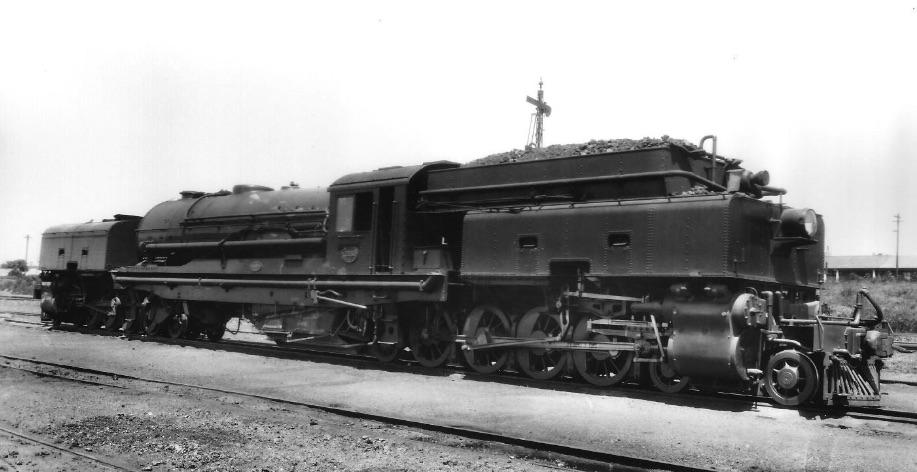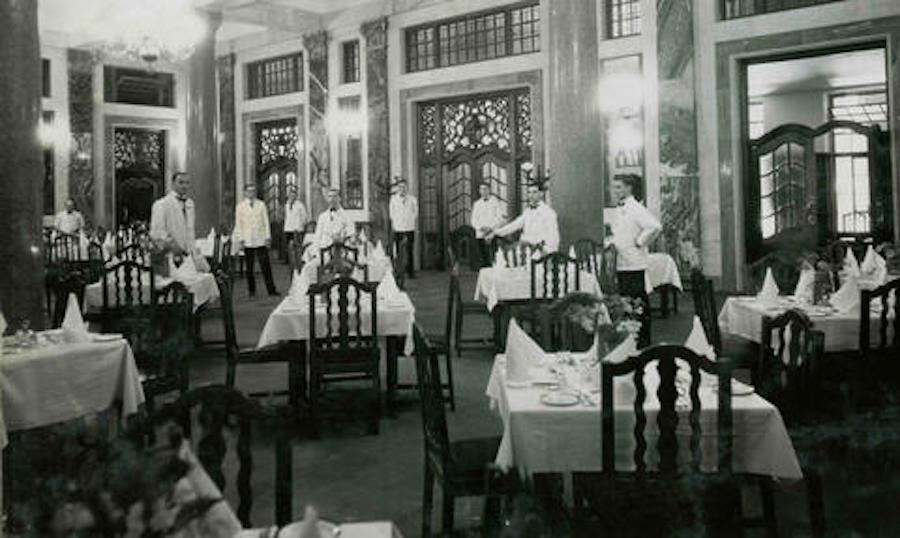
Disclaimer: Any views expressed by individuals and organisations are their own and do not in any way represent the views of The Heritage Portal. If you find any mistakes or historical inaccuracies, please contact the editor.
I was Assistant and for extended periods, Acting Curator of the previous South African Railways Museum in Johannesburg from 1972 when it was still housed under Rissik Street Bridge at the station as it had been since 1956 and then from 1973, in South Station Building which housed the 1932 station concourse and the famous ‘Blue Room’ Restaurant - reached from the main entrance to the old Johannesburg Station off de Villiers Street – corner of Eloff St.
This is the Museum staff in 1973 photographed in the 1932 Station Concourse in front of the NZASM ‘Emil Kessler’ 14-Tonner locomotive. Left to right: Charles McLean, Museum Assistant, Dan Grib, Correspondence Clerk, Mr.Venter, Museum Carpenter, Johnny Orsmond, Museum Display Artist, Les Pivnic, Assistant Curator, Jan Coffee, Curator, Winnie Venter, Research Officer, Frank Cage, Museum Guide, Harold Rennie, Carpenter, Pietro Sabatelli, Workshop staff and Gordon Payne, Accessions Clerk.
Returning briefly to the Museum as it was under the Rissik Street Bridge, here are a few photos of the Museum in that period 1956 – 1972:
A small portion of the wonderful collection of model SAR trains which was originally made in the UK by professional model-making firms for the ‘Ter-Centenary’ Celebrations in Cape Town in 1952. Mr.D.H.C Parkin (left) Director of the Museum 1956 - 1969 and Mr.Ralph King, Senior photographer discussing the models.
A wide variety of exhibits
As can be seen from the photo-collage above, the Museum displayed a wide variety of exhibits ranging from office equipment to models of SAR trains, locomotives, tugs, aircraft, Road Motor vehicles, and items related to all the other remaining services operated by the SAR Administration. Then came the big move to South Station Building in 1973. A set of new showcases was specially ordered for placement in the large concourse and with my previous window-dressing experience, I dressed the new showcases with a similar wide variety of museum material. We also occupied the previous Gents Bar which became our ‘Models Room’ while the adjoining room housed our catering equipment which included crockery and glassware from the 1947 Royal Train. Below are a few of the new displays in the Concourse:
'New' displays
We also housed the famous Pierneef Collection of paintings that had previously been displayed in the station concourse. We had a full-size mock-up (using real parts) of a steam locomotive cab - class 15F with sound effects recorded on an actual 15F locomotive. An all-electric power signal console with miniature levers was on display (see photo above). As a centre-piece of the whole Museum, we had the NZASM 14-tonner ‘Emil Kessler’ steam locomotive that was used on the so-called ‘Rand Tram’.
Pierneef Panels (Transnet Heritage Collection & Rupert Museum)
At this time and as instructed by Minister of Transport, Ben Schoeman, I became active in selecting examples of locomotives - steam and electric which were being withdrawn from service at the end of their active service lives, for preservation in our planned major Museum. I was also heavily involved with selecting notable candidates from ageing rolling stock (coaches, dining cars) as they too, were being replaced by new equipment. Simultaneously, we in the existing Railway Museum, were actively looking for premises to accommodate a new major world-class Railway Museum which would house all the newly acquired large museum exhibits like the locomotives and coaches etc.
Initially, we had a 103-acre undeveloped site allocated to us for the new Museum – adjoining the Railway College at Esselen Park near Kaalfontein station on the railway line between Germiston and Pretoria. Then the first set-back hit us – our site was declared unsuitable because it was discovered that the site was situated on dolomitic soil which could cause sink-holes to develop. That put paid to the Kaalfontein site for the major museum.
Old Park Station at Esselen Park
Then a turn of events occurred that changed everything – the major Mechanical Workshops at Pretoria moved to new premises at Koedoespoort which left the old Pretoria Shops vacant! This is just what we needed – ready-made buildings that would just need remodelling to provide a perfect home for the new Museum.
The new Museum’s prospects now looked extremely bright because we had decided to occupy the vacated premises of the old Workshops in Pretoria which adjoined the main railway station, making public access very easy. To top that – direct rail access was immediately available, allowing immediate entry for incoming museum exhibits! The new Museum’s prospects couldn’t have been brighter.
Pretoria Railway Station. The Kruger Statue was moved to Church Square in the 1950s. (Les Pivnic)
In 1981 and again in 1983 the Railway Administration sent me to Europe and the UK to study notable Railway Museums in Germany, France, Holland, Switzerland and the United Kingdom in order to formulate plans for the layout of our new Museum. I wrote extensive illustrated reports on my visits to each and every Museum that I visited. On the strength of those reports and my own further recommendations, I drew up an extensive plan for our own new Museum which would have placed it in company with the best in the world.
Then disaster struck. The Pretoria City Council advised the Railway Administration that they couldn’t agree to redevelopment of the old Railway Workshops at Salvokop because they had major roadworks planned for that immediate area.
The Pretoria Railway Workshops (Les Pivnic)
The Railways System Manager accepted their objection and advised us of this news. We had lost the perfect home for the new major Museum.
Initially, we looked for yet another home for the new Museum and we had to accept a major compromise in that we were given permission to develop the new Museum at the Krugersdorp Steam and Diesel Locomotive Depot which in effect was a massive down-grade from what we had planned for Pretoria.
We then arranged for all our stored locomotive and coach exhibits stored mainly at De Aar, to be sent to the Krugersdorp Loco Depot so that they could be on hand when the new Museum was physically developed.
Then the biggest blow of all hit us. In the mid-1980s, a directive from the Railways Management came through to the effect that no further major expenditure would be approved. I was personally devastated to the point where it affected my health. I was put on sick-leave in 1988 pending being boarded on pension a year later. After I left, Krugersdorp Loco Depot also lost favour as a site for the new Museum and my successors managed to get some funds allocated to establish a new Museum in the previous ‘PX Goods Depot’ attached to George Railway Station in the Southern Cape.
This Museum fell way short of what we had planned earlier and most important – George was a limited rail destination in that it was accessed by 60lb rail from all sides and this restricted sending heavy main line engines as exhibits to the Outeniqua Transport Museum (OTM) as the Museum in George was known. One engine, a heavy main line class GL Garratt was in fact sent to the OTM in George but this was against normal standing regulations, as a one-off exercise. Normally, only engines with lighter axle-loads would be permitted to run on 60lb track. It is important to note that the South African Railways was world-renowned for the size of its main line engines on the narrow 3ft 6in gauge. Our locomotives were bigger, heavier and more powerful than anything in the UK and were right up with anything running in Europe in terms of power and size. So, it was extremely important that a new Museum should be sited in South Africa where heavy main line engines could freely be sent to for preservation.
Class GL Garratt
Finally, the staff that were sent down to the OTM were not museum-trained people having been drawn from ordinary railway clerical staff with limited railway history knowledge. In a nutshell, the major world class railway museum that had been planned was further derailed by massive political changes that would occur in South Africa in 1994, resulting in the earlier plans being set aside. A large proportion of what would have been valuable major exhibits in the planned museum, have as a result of those political changes already been scrapped and are no longer available to be proudly displayed in a museum, so the chances of a world class railway museum being established in South Africa are most unlikely.
Main image: The Blue Room at Park Station
About the author: Les was born in a private house in Brixton on July 7, 1935. He attended Twist Street Primary School from 1946 to 1948, after returning from Durban where he spent 3 years during World War II attending Addington Primary School when his dad was in the Army. He attended Parktown High and after that, he started his working life for the CNA in their Fancy Goods Department. Les then trained as a window dresser with Jacoby & Co in Kerk Street where he remained for 15 years of his working life. All this time, his heart was in railways and he had made a private study of the SAR's steam locomotives and other rolling stock - especially dining cars. This led to an invitation from the SA Railway Administration to join the SA Railway Museum as Assistant Curator in July 1972. He was overjoyed at this development and remained in their employment for the remaining part of his working life. During this time, SA Transport Services published his book on the history of all catering vehicles used on the SAR - dining/kitchen/lounge cars etc. He was boarded on pension in 1989.
Comments will load below. If for any reason none appear click here for some troubleshooting tips. If you would like to post a comment and need instructions click here.

